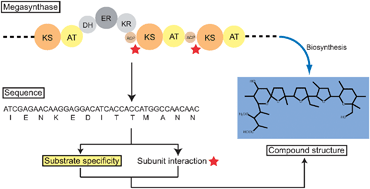Bioinformatic perspectives on NRPS/PKS megasynthases: Advances and challenges
Abstract
Covering: 1997 to 2008
The increased understanding of both fundamental principles and mechanistic variations of NRPS/PKS megasynthases along with the unprecedented availability of microbial genome sequences has inspired a number of in silico studies of both enzyme families. The insights that can be extracted from these analyses go far beyond a rough classification of data and have turned bioinformatics into a frontier field of natural products research. As databases are flooded with NRPS/PKS gene sequences of microbial genomes and metagenomes, increasingly reliable structural prediction methods can help to uncover hidden treasures. Already, phylogenetic analyses have revealed that NRPS/PKS pathways should not simply be regarded as enzyme complexes, specifically evolved to produce a selected natural product. Rather, they represent a collection of genetic options, allowing biosynthetic pathways to be shuffled in a process of perpetual chemical innovation. Understanding the principles underlying domain specificities,


 Please wait while we load your content...
Please wait while we load your content...